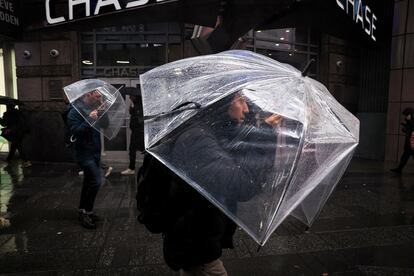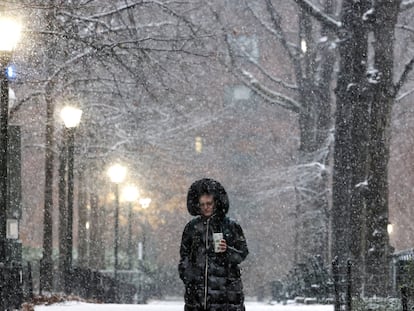Much of central US faces severe thunderstorm threat and possible tornadoes
Severe scattered thunderstorms are also expected to bring strong winds, hail and flash flooding

Tens of millions of Americans stretching from Lincoln, Nebraska, to Baltimore could face strong thunderstorms Monday night through Wednesday, with tornadoes possible in some states.
A large storm system hitting much of the central U.S. over the next few days is expected to bring severe thunderstorms to Kansas and Nebraska on Monday evening, the National Weather Service’s Storm Prediction Center said.
The two states could see strong tornadoes, too, while parts of Oklahoma, Missouri and Virginia face a slight risk.
Severe scattered thunderstorms are also expected to bring strong winds, hail and flash flooding.
What areas are most at risk?
After moving through the Great Plains, NWS says the storm system could move into the Mississippi Valley, Great Lakes and Ohio Valley areas on Tuesday and bring “severe weather and isolated flash flooding.”
Southern Iowa, Northern Missouri and Central Illinois face the largest threat of “significant hail and tornado potential” on Tuesday, the agency said.
The risk of tornadoes forming Monday evening over parts of Kansas and Nebraska will increase with the development of a few, discrete supercells, NWS said. Those are the tall, anvil-shaped producers of tornadoes and hail that have a rotating, powerful updraft of wind, often lasting for hours.
When is tornado season? Is it changing?
May is generally considered the midpoint of tornado season, said Harold Brooks, a tornado scientist at the National Severe Storms Laboratory.
Brooks said late April to the middle of May is when the strongest tornadoes that cause fatalities usually appear.
“There’s a lot of uncertainty in those estimates,” Brooks added, because of how much each tornado season varies year to year.
Some scientists believe that over the past few decades, tornadoes in the U.S. have been shifting — with more spinning up in states along the Mississippi River and farther east. But scientists aren’t entirely sure why that’s happening.
One possible factor could be that the western Great Plains are getting drier thanks to climate change, said Joe Strus, a meteorologist with the National Weather Service, “and so your precipitation has shifted east a little bit.”
Sign up for our weekly newsletter to get more English-language news coverage from EL PAÍS USA Edition
Tu suscripción se está usando en otro dispositivo
¿Quieres añadir otro usuario a tu suscripción?
Si continúas leyendo en este dispositivo, no se podrá leer en el otro.
FlechaTu suscripción se está usando en otro dispositivo y solo puedes acceder a EL PAÍS desde un dispositivo a la vez.
Si quieres compartir tu cuenta, cambia tu suscripción a la modalidad Premium, así podrás añadir otro usuario. Cada uno accederá con su propia cuenta de email, lo que os permitirá personalizar vuestra experiencia en EL PAÍS.
¿Tienes una suscripción de empresa? Accede aquí para contratar más cuentas.
En el caso de no saber quién está usando tu cuenta, te recomendamos cambiar tu contraseña aquí.
Si decides continuar compartiendo tu cuenta, este mensaje se mostrará en tu dispositivo y en el de la otra persona que está usando tu cuenta de forma indefinida, afectando a tu experiencia de lectura. Puedes consultar aquí los términos y condiciones de la suscripción digital.
More information

Winter storm hits Northeast, causing difficult driving, closed schools and canceled flights
Archived In
Últimas noticias
The complicated life of Francesca Albanese: A rising figure in Italy but barred from every bank by Trump’s sanctions
Reinhard Genzel, Nobel laureate in physics: ‘One-minute videos will never give you the truth’
Pinochet’s victims grapple with José Antonio Kast’s rise in Chile
How Japan is trying to avert ‘digital defeat’
Most viewed
- Pablo Escobar’s hippos: A serious environmental problem, 40 years on
- Reinhard Genzel, Nobel laureate in physics: ‘One-minute videos will never give you the truth’
- Why we lost the habit of sleeping in two segments and how that changed our sense of time
- Charles Dubouloz, mountaineering star, retires at 36 with a farewell tour inspired by Walter Bonatti
- The Florida Keys tourist paradise is besieged by immigration agents: ‘We’ve never seen anything like this’









































